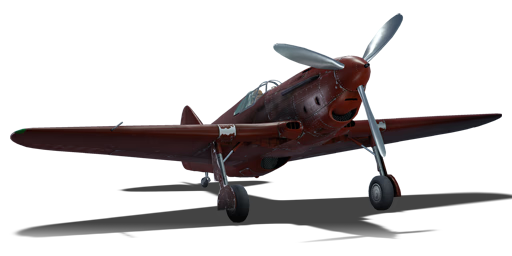


The I-301 was the prototype for the LaGG-3 fighter series, and so construction, and flight characteristics and performance are similar to them. Unlike many fighters, the I-301 was made out of wood and polymer, which contributed to its flying capabilities. Contrary to popular belief, the wooden construction was quite resistant to catching fire. A successful prototype made its maiden flight in March, 1940. The aircraft was powered by a 12-cylinder liquid-cooled Klimov M-105P radial engine with a rated output of 1,050 HP and its armament was, at the beginning, insanely powerful for its time. It used a 23 mm PTB-23 cannon with 81 rounds of ammunition. The aircraft suffered from poor operational range and thus, two extra fuel tanks were added in the wings.
It was introduced during Update 1.43 as part of a giveaway in the 2014 Winter Holiday event. Currently you can only acquire an I-301 coupon in a trophy or buy one at the Gaijin market to unlock this aircraft. There is almost no difference between the I-301 and the researchable LaGG-3-8. Besides being only marginally faster than the rank II LaGG-3-66 in level flight and in a climb, the I-301 shares many of the characteristics of the LaGG-3-8, with the exception of the massive increase in firepower. The I-301's firepower is a step above the other LaGG-3 fighters due to the extra machine guns and powerful cannon. The cannon is a 23 mm PTB-23 cannon, which in-game is similar to the 23 mm on the IL-2 attackers. As for machine gun armaments, the I-301 has two 12.7 mm HMGs as well as a single 7.62 mm machine gun. With four machine guns and a cannon mounted in the V of the engine, the I-301 is a well-armed fighter for its BR. With its flight characteristics, it is a fighter well-suited for boom and zoom tactics. However, it catches fire easily like the LaGG-3 due to the wing-based fuel tanks and the engine is prone to overheating rather quickly.
flaps
flaps
flaps
brake
| Belt | Belt filling | Armor penetration (mm) at a distance: | |||||
|---|---|---|---|---|---|---|---|
| 10 m | 100 m | 500 m | 1000 m | 1500 m | 2000 m | ||
| FI-T/AP-I | 46 | 42 | 29 | 19 | 12 | 8 | |
| FI/FI-T/AP-I | 46 | 42 | 29 | 19 | 12 | 8 | |
| AP-I/AP-I/AP-I/FI-T | 46 | 42 | 29 | 19 | 12 | 8 | |
| Belt | Belt filling | Armor penetration (mm) at a distance: | |||||
|---|---|---|---|---|---|---|---|
| 10 m | 100 m | 500 m | 1000 m | 1500 m | 2000 m | ||
| T/AP/AP/IAI | 32 | 30 | 22 | 15 | 11 | 7 | |
| AP-I/API-T/IAI/IAI | 29 | 27 | 20 | 13 | 9 | 6 | |
| API-T/AP-I/AP-I/IAI | 29 | 27 | 20 | 13 | 9 | 6 | |
| AP-I(c)/AP-I/AP-I/API-T/IAI | 34 | 32 | 24 | 17 | 12 | 8 | |
| API-T | 29 | 27 | 20 | 13 | 9 | 6 | |
| AP-I/AP-I/IAI | 29 | 27 | 20 | 14 | 9 | 6 | |
| Belt | Belt filling | Armor penetration (mm) at a distance: | |||||
|---|---|---|---|---|---|---|---|
| 10 m | 100 m | 500 m | 1000 m | 1500 m | 2000 m | ||
| T/Ball/Ball/AP-I/AI | 13 | 12 | 7 | 3 | 2 | 0 | |
| AP-I/AI/API-T | 13 | 12 | 7 | 3 | 2 | 0 | |
| AP-I/API-T | 13 | 12 | 7 | 3 | 2 | 0 | |
| AP-I/AP-I/AP-I/AI | 13 | 12 | 7 | 3 | 2 | 0 | |







 2 x (35 / 60 / 140) %
2 x (35 / 60 / 140) % 
 2 x 112 %
2 x 112 % 

Flight performance | |
|---|---|
Survivability |
|---|
Weaponry | |
|---|---|